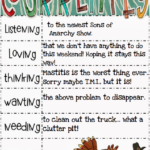|
After using Whole-Brain Teaching rules for 8 years I gave up them up and here’s why.
Like many of you I fell in love with Whole Brain Teaching. It is engaging and aligns so easily with
who I am as a teacher. Like all teachers however, we need to stay fresh. We need to be continuously reflecting on our practice. As I began planning last year I started looking at the way I manage my classroom. I tried to put myself in the place of my students, to try to see the impact my practices might have had on me as a child. I began with my Whole Brain Teaching rules. I thought about what happens when a student is breaking a rule. As a
community we recite the rules as a “reminder”. The behavior is usually corrected and we move on. As the teacher, I got what I wanted; the kids are back on track. But I started to think about how I would have felt if I were one of my students. Rule #3 is Raise Your Hand for Permission to Speak. I could have easily been a child caught whispering to a friend. My teacher, along with the rest of the class would recite the rule to get us all back on track, but really I know it’s about me and the mistake I made. I feel like everyone is looking at me and I may even dwell on it for the rest of the day or carry the feeling it left me with home that night.
It was time to try something different. Now I don’t want to say that I gave up Whole Brain Teaching or the style of it all, because that is definitely not the case. I love Whole Brain, but it’s also important to think about how you are carrying it out and I wasn’t doing it in the best way at the time.
Instead of rules we now have community agreements. We started off brainstorming what kinds things we needed to think about if we were going to have a classroom that ran smoothly, where everybody felt safe, where everybody felt cared about. We wanted it to be a place where everybody wanted to come to school every day. Our list grew and we started started pulling out key words to include in our agreements. I really emphasized that I would be unable to make the agreements without their help. I carefully folded up our charts and placed them in my teacher bag to go home with me that night so I could type up three agreements that encompassed all of their thinking.
As teachers we know what they will come up with when it comes to creating a positive classroom community. They’re the same things we would want. I already had our agreements ready to go and I “brought” them along with me to school the next day.
We talked about what a commitment is, what it means to commit to something, We also talked about what happens to our community if we break those commitments and how that impacts everybody in the community. Here are the agreements we have committed to:
They may seem like a bit of a mouthful, but the kids know them well and they are truly committed to upholding them.
Giving up Whole Brain rules after so many years was a transition for me. I had to train my brain and even found myself beginning to recite a rule at times. It was that ingrained in me.
We loved our agreements and as a community we were proud that we created them together. Something was missing though. We need to move. We needed to chant. It didn’t take long and we created motions to go along with each agreement. We recited them throughout the day as we needed to, but never in a way that would single any community member out. |
|||||||||
|
Our agreements helped create our community. We were each dedicated to following them, and when they themselves or somebody else in the community wasn’t following a commitment they felt okay to talk about it. They encouraged one another and helped one another “recommit” to our agreements when one had been forgotten.
Every morning we start the day by reciting our commitments. We discuss any parts of our day where we might need some extra emphasis on a particular agreement. It’s a great way to begin and solidify our learning community.
One other piece that I did that just happened as the agreements rolled out, is talking about “choosing in”. We talked a lot about how it is a choice to be part of our community, it is a choice that they make for themselves.
|
|||||||||
|
Anytime that we were struggling to follow these commitments, or a student was struggling to follow these commitments, I would have a one on one conversation with them and ask, “Do you choose in?” And up until the day before the last day of school, I never had an issue with it. They would always reply with something like, “Oh no, I choose in. I want to be a part of this community, I’m going to recommit to __________,” That was it. They didn’t want to choose out and to be honest until nearly the last day of school I didn’t know exactly what I would say if they did say they wanted to choose out.
But, the day before the last day of school I was talking with a student and he said, “No, I choose out.”
I thought, “Oh no. What do I do? What does that look like?” So I just asked him, “Well what does that look like to you? What does choosing out look like to you?”
And he said, “I just think I need to take a break from the community for a few minutes.” That’s what it looked like to him, and he just stepped out for a minute, and took a break, and came back when he felt ready to recommit to those agreements. It was pretty awesome to see that happen for him, and for him to be able to pinpoint what that looked
like for him. |
|||||||||
|
If you have done Whole Brain Teaching for a while, and you love it, then think about changing it up and doing something different. As teachers it’s important to try new things and to stay challenged.
If you’re thinking about making the switch and want to save time getting started you can find these editable posters in my TpT store HERE or by clicking any of the pictures in this post.
How you could incorporate community commitments into your classroom?
|




















Good Morning and Happy Summer!
What kind of chants and motions did you come up with for your commitments? Would love to hear more. Thanks so much!